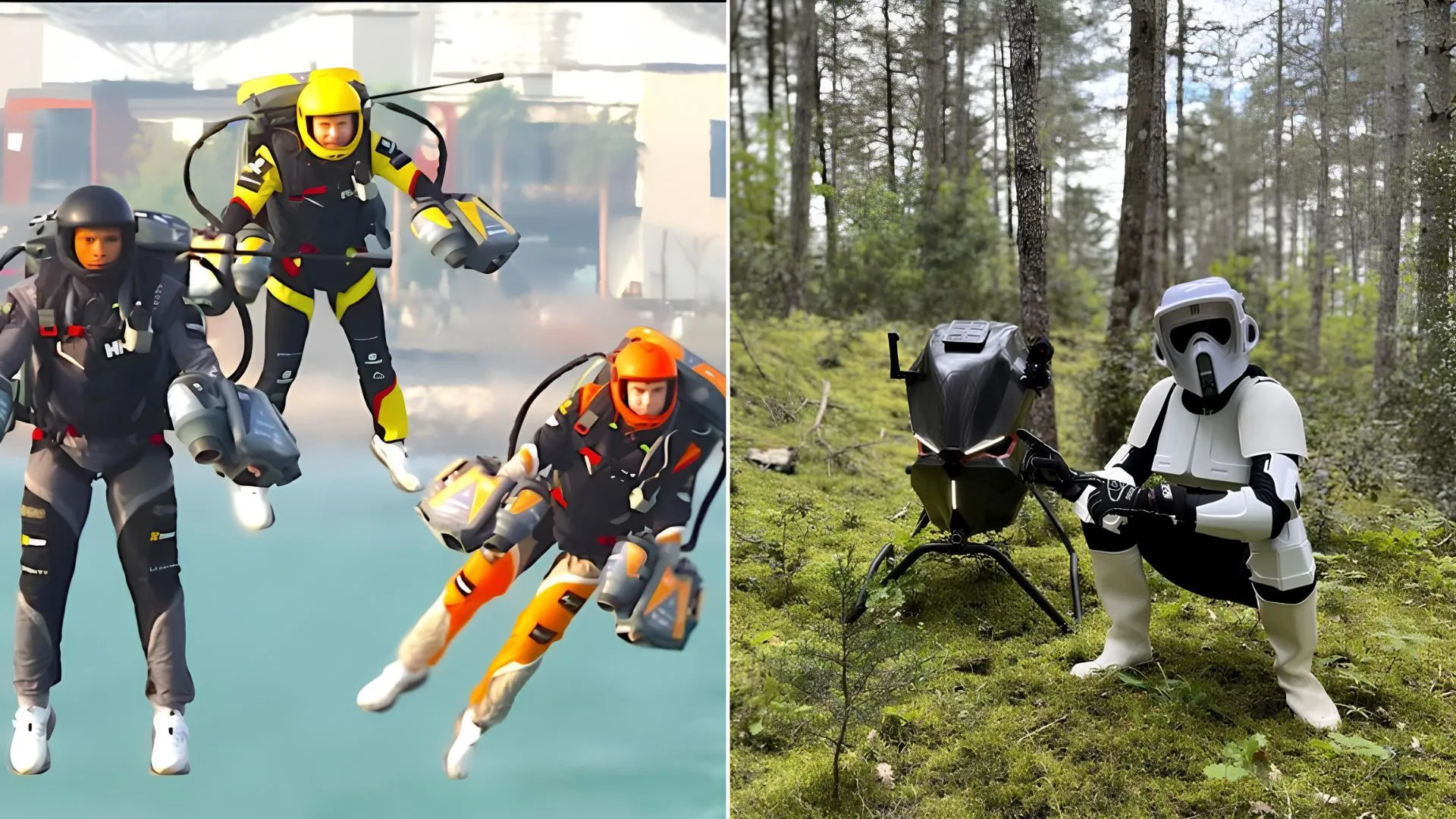Copyright Interesting Engineering

For decades, the dream of personal flight, as envisioned by jetpacks, hoverboards, and flying cars, has captured our imagination. The idea is simple yet profound. The freedom to lift off and travel anywhere, anytime, with no traffic or roads to restrict you. Yet, nearly a quarter of the way into the 21st century, these personal flying machines remain inaccessible. The irony is that the technology now exists. Engineers, startups, and enthusiasts worldwide are already building functioning models in workshops and garages. So why are we still waiting for takeoff? The rise of the EVTOL era Most of today’s personal flying vehicles fall under the category of EVTOLs (Electric Vertical Takeoff and Landing aircraft). These are essentially large drones powered by batteries or hydrogen fuel cells, capable of lifting one or more passengers vertically into the air. Advances in drone technology, particularly in flight stabilization and obstacle avoidance, have made such vehicles technically feasible. FPV (First Person View) drone enthusiasts have also played an important role in this development. Their do-it-yourself culture, supported by tech like 3D printing, accessible electronics, and online tutorials, has successfully democratized small-scale aviation. Today, almost anyone with enough curiosity and skill can assemble an aircraft capable of short human flight. From garages to skies: DIY innovators and their machines A key figure in this grassroots movement is Hunter Kowald, founder of Sky Surfer Aircraft, Inc. His rotor-powered flying skateboard, the Sky Surfer, has become a viral sensation, blending extreme sports aesthetics with serious engineering. Capable of flying at 40 mph for 20 minutes and lifting 500 pounds, the Sky Surfer does a very good job at showing just how close homemade aviation has come to commercial viability. Another company, Omni Hoverboards, pursues a similar path, while Ascend Dynamics experimented with a jetpack-style system using twelve rotors mounted in a backpack configuration. Although that project appears to have paused, it reflects the diversity of approaches emerging within the ultralight flying machine scene. Jetpacks and airbikes are no longer Sci-fi While DIY innovators experiment with compact rotor systems, other companies are drawing inspiration from the world of cinema. Gravity Industries’ jetpack mirrors Iron Man’s propulsion system, using hand-mounted microjets to steer through the air with human arm movements. Meanwhile, Volonort Airbike takes cues from Star Wars, resembling a speeder bike capable of reaching 124 mph through jet propulsion. Both projects have successfully demonstrated working prototypes, and Volonort even accepts pre-orders. However, their reliance on jet fuel makes them less accessible to everyday users. They’re powerful demonstrations of engineering, but unlikely to replace cars anytime soon. Enter the flying car Above the ultralight class sits the next big leap: the flying car. Among the most publicized examples is the Jetson ONE, developed by a Polish company. Looking like a scaled-up drone with eight rotors and a single-seat cockpit, it can fly for 20 minutes at over 100 mph. With a price tag of $150,000, Jetson is positioning its vehicle not as a toy for the wealthy but as a potential tool for first responders and mountain rescue missions. Then there’s ALEF, a company whose very name, The Flying Car, says it all. Their model blurs the line between ground and air vehicles, featuring a mesh body that allows air to flow vertically through it. On the road, it can drive up to 25 mph, but when conditions permit, it can transform and take off, achieving a flight range of approximately 110 miles. The system even includes a gimballed cockpit to keep passengers level during transitions. Large-scale players: Sky taxis and commercial EVTOLs While smaller companies experiment with personal vehicles, established players are chasing the urban mobility market. Archer Aviation and Joby Aviation are at the forefront of developing multi-passenger EVTOLs that could one day serve as air taxis. Archer’s Midnight model is fully battery-powered, capable of carrying four passengers and a pilot at speeds up to 150 mph. Designed for short urban commutes of 20 to 50 miles, it could revolutionize travel in congested cities like New York. Joby Aviation, meanwhile, is testing hydrogen-powered aircraft capable of longer journeys, recently completing a 523-mile flight. The company plans to launch air taxi services in the UAE, underscoring the global nature of the race for commercial EVTOLs. Why not just use helicopters? Given their capabilities, it’s fair to ask why we need EVTOLs at all when helicopters already exist. Helicopters are proven, versatile, and can fly for hours on a single tank of fuel. But they’re also noisy, expensive, complex, and limited by strict regulations. EVTOLs, by contrast, promise to be quieter, cheaper, simpler, and more environmentally friendly. Unlike helicopters, which rely on large mechanical engines converting fuel explosions into rotational motion, EVTOLs use multiple electric motors powered by batteries. Each rotor operates independently, providing redundancy in the event of motor failure. The absence of combustion also means less noise and lower emissions, making them suitable for urban environments. The battery problem and its future One of the biggest challenges for EVTOLs is the need for efficient energy storage. Batteries are heavy, and as aircraft grow in size, so does the weight of the batteries required to lift them. This creates a vicious cycle where adding more batteries to increase flight time actually reduces efficiency. Some companies, like Joby, are exploring hydrogen fuel cells as an alternative. Hydrogen offers higher energy density, but comes with safety and cost concerns. It’s difficult to store, potentially explosive, and expensive to produce sustainably. For now, most manufacturers, such as Archer, are sticking with batteries, betting that advances in battery technology will soon close the performance gap. This isn’t far-fetched. Automotive battery makers are developing packs capable of over 800 kilometers per charge, with higher power density and reduced weight. Emerging sodium-based batteries could further advance this, offering safer, lighter, and more temperature-resistant power solutions. Intelligent skies: Automation and safety Just as drones revolutionized aerial photography, they are now shaping the future of flight safety. Many EVTOLs integrate drone-like autonomy features, such as stabilization sensors, proximity detection, GPS guidance, and automatic “return to home” systems, to make flying as easy as driving. In contrast to traditional helicopters, which require skilled pilots, future EVTOLs may need little or no manual control. Some models will offer assisted flight, while others could be fully autonomous, relying on GPS and obstacle detection to avoid collisions. With fewer obstacles in the air than on the road, autonomous flight might actually prove safer than driving. Clean, quiet, and cost-effective The environmental and economic advantages of EVTOLs are compelling. Electric propulsion eliminates direct fuel combustion, reducing pollution and noise. Maintenance costs are also expected to be significantly lower, up to 50% less than those of helicopters, due to the simplicity of electric motors and the absence of complex mechanical linkages. Hydrogen, while cleaner in theory, introduces its own complications, from containment risks to the environmental impact of production. Nevertheless, hybrid systems combining batteries with hydrogen backup cells may offer a middle path in the short term. Regulation is he final frontier Technology isn’t the only hurdle. Aviation laws, built around traditional aircraft, are struggling to adapt to this new class of vehicles. Larger EVTOLs must undergo rigorous, multi-year testing to meet the standards set by authorities like the FAA. Joby Aviation, for example, has already completed three of five stages in its FAA certification process. Smaller ultralight models, however, like the Sky Surfer, may have an easier path. Classified under the ultralight category, these vehicles can be flown for recreation with fewer restrictions, provided users undergo proper training and adhere to safety protocols. In theory, someone in the U.S. could already fly a personal hoverboard or jetpack legally today. Ready for takeoff. Almost. The personal flight revolution is no longer a fantasy. The technology exists, the prototypes are flying, and the investment money is flowing. Yet, challenges such as battery weight, regulation, safety, and scalability still hinder most projects. A future where commuters soar over traffic may still be years away. But the sight of a flying skateboard buzzing across the skyline? That could happen much sooner than we think. The skies are opening up, not for airlines, but for individuals ready to take control of their own flight.



